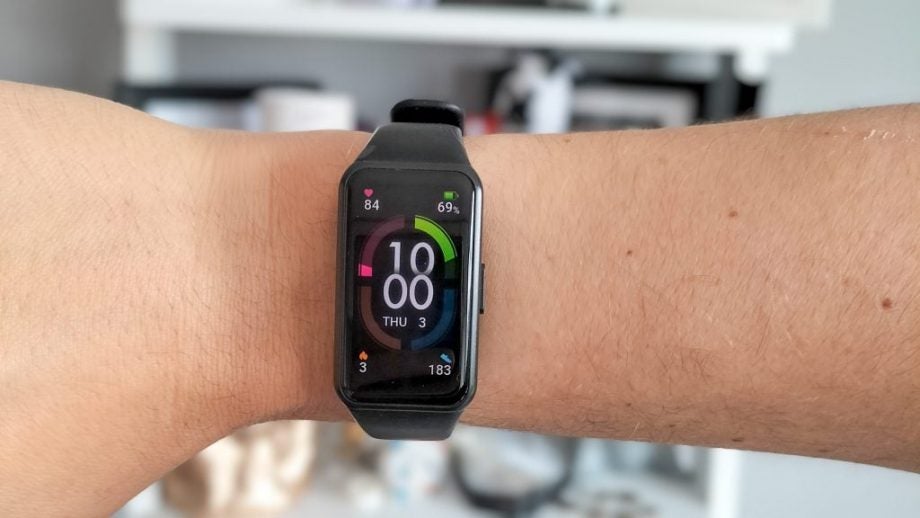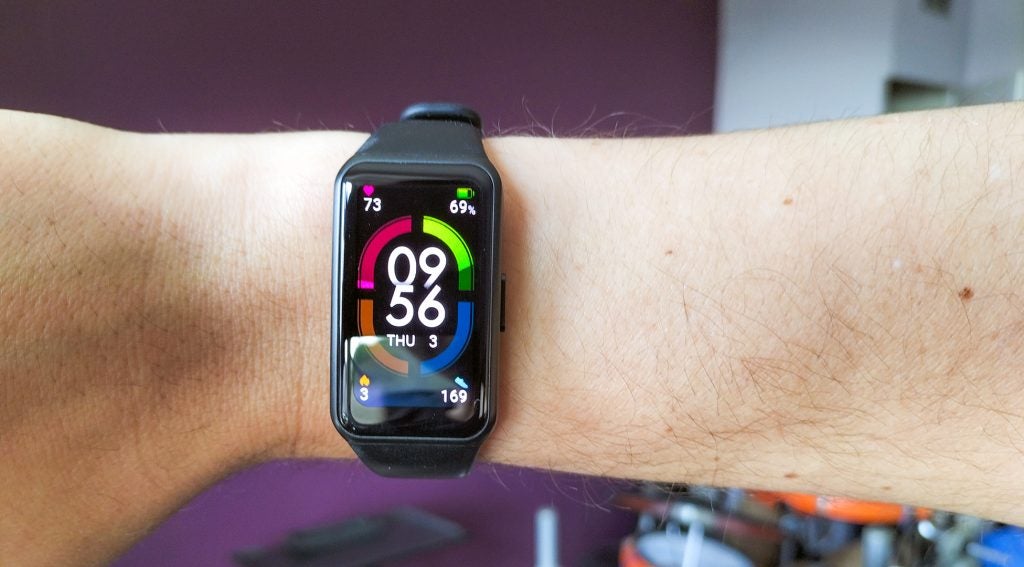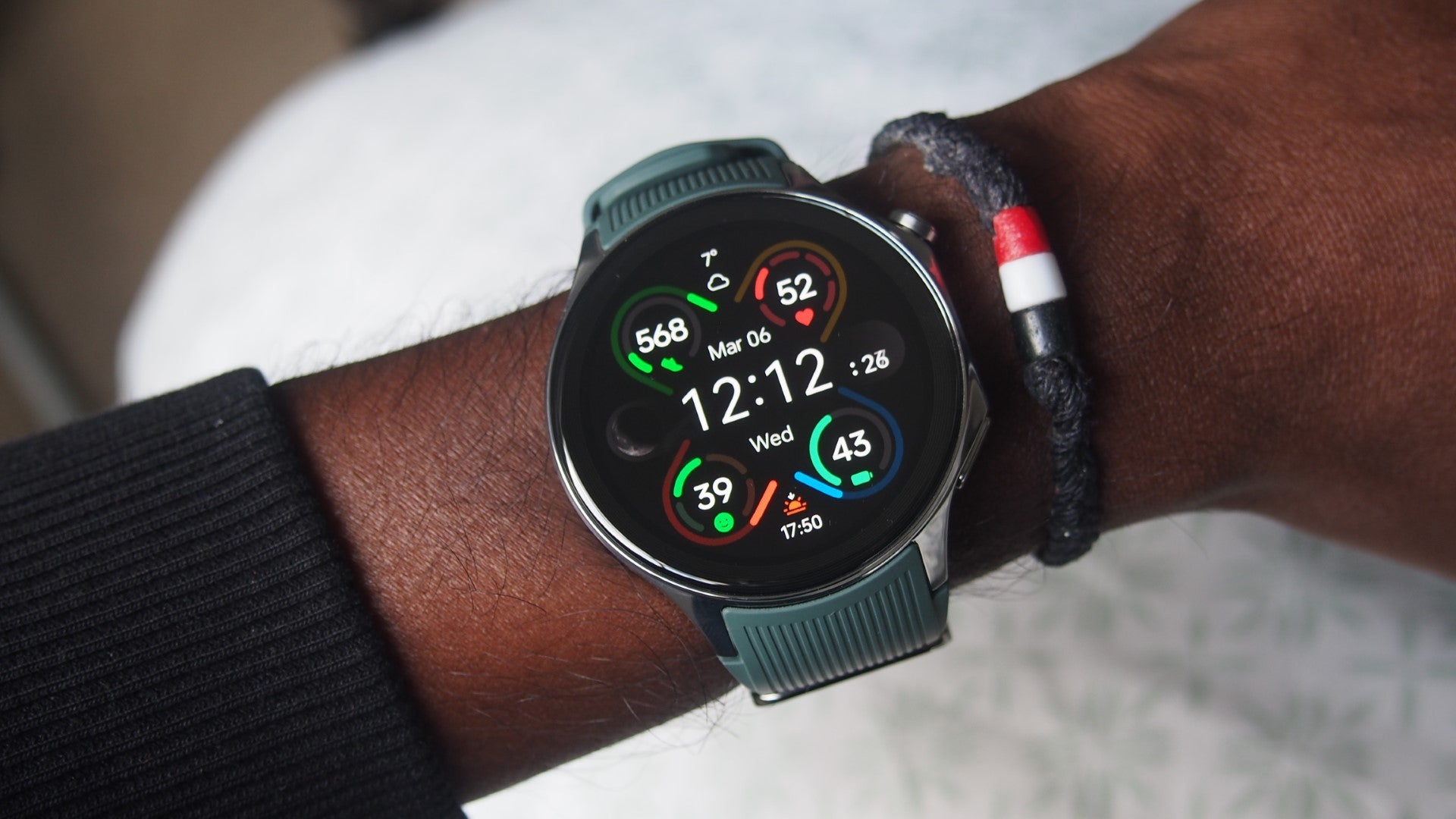Honor Band 6 Review
An excellent budget tracker


Verdict
I find the Band 6 great fun to use, largely easy to live with, comfortable, and more-or-less the perfect size. Many will prefer wearing an Honor Band 6 to a larger, heavier watch such as the Huawei Watch GT 2 or an Apple Watch SE. But, it isn’t without issues.
Pros
- Great value
- Excellent screen and interface
- Good on-screen health metrics
- Fun to use
Cons
- Lacks Full GPS
- Connected GPS is part-broken
Availability
- UKRRP: £44.99
- USAunavailable
- Europeunavailable
- Canadaunavailable
- Australiaunavailable
Key Features
- Long battery lifeThe Honor Band 6 lasts 10-14 days between a charge, meaning it requires far less upkeep than a more expensive smartwatch.
- Bright OLED screenAn unusually sharp and colouful OLED screen gives the Band 6 a glossy look that was not on offer in fitness trackers this affordable until recently.
- SpO2 readingsThis band can monitor your blood oxygenation as well as your heart rate. It’s this season’s hot wearable feature.
Introduction
The Honor Band 6 is a cheap fitness tracker that represents a major generational leap over what you could buy at the price before.
The Honor Band 6 doesn’t feature GPS and its implementation of Connected GPS, usually a good replacement for the real deal, is a bit broken. The result is that, unlike most phones, you’ll have to start a fully tracked and mapped workout on your phone, not on the band itself.
Huawei’s Band 6 likely has the same issue, making the Huawei Watch Fit the best upgrade if the Honor Band 6’s issues are a concern. That’s a lovely watch for around £80 – although it may be more than you’re willing to spend.
Despite its shortcomings, however, I believe there’s plenty of room for the Honor Band 6, given how much more it offers over the budget Fitbit and Samsung alternatives.

Design and screen
- Petite fitness band charm with smartwatch gloss
- Decent tempered-glass screen cover, but otherwise plastic
This review of the Honor Band 6 is likely to be one of the more positive you’ll read, if you’re the kind of person who researches your tech buys a lot. My job is to explain why.
It mostly comes down to the same reason I’ve recommended Huawei and Honor fitness bands and wearables for years. Many of these devices appear to offer a great deal. The Honor Band 6 does, too.
Just look at it. The Honor Band 6 features a lovely OLED screen with slim borders, punchy colours, a high resolution and a tempered-glass surface.
It’s a great example of how affordable fitness bands have developed, and are developing. The Honor Band 6 offers a middle-ground between basic fitness trackers that cost peanuts, and smartwatches. I think it’s a good place to be.
Chinese companies such as Honor, Huawei and Xiaomi are well ahead here. Samsung’s Fit 2 is good, but is more like the last-gen Huawei and Honor bands. The Fitbit Luxe is more than double the price.

You just get more gloss with this Honor, and its 1.4-inch screen keeps it looking more like a fitness band than the larger Honor Watch ES or Huawei Watch Fit. The strap is decent, too. It’s a standard watch-style strap, not the “fold over and under” kind that seems to be popular – I find the latter quite annoying as someone who tends to take their watch on and off quite regularly.
There are limits to Honor’s bargain mining, of course. The Band 6’s body is plastic rather than aluminium, and it misses out on several important features. I’ll cover most of these later, but automatic brightness is one to touch on now. You have to set the brightness here manually, and there’s no easy-access control for this – which seems silly, given there’s a dropdown shortcut menu for features such as Do Not Disturb and Alarms.
I find the watch holds up fine for outdoor runs at its default ‘3 out of 5’ brightness setting, but auto-brightness would really have enhanced this watch, ramping up brightness to the max outdoors, and bringing it back down once you were indoors.

Software
- Excellent interface makes the Honor Band 6 fun to use
- Good use of screen space at the price
So, the Honor Band 6 is a good deal because it has a big colour screen? There’s more to it than that.
Honor makes good use of the larger-than-average 1.4-inch screen space because its software is surprisingly similar to that of Honor’s larger, more expensive round watches.
There are two main parts to it. Flick left and right from the clock face and you get to widget screens for features covering your daily activity, heart rate, stress, the weather and music playback. That’s ordinary enough, but the Honor 6 offers neat little graphs of your results for that day.
On the heart rate page, for example, you’ll see a daily graph alongside your current heart rate, your maximum heart rate and your min/max figures for the day. Not a square centimetre is wasted. And I find this encourages me to look at such data more often.

Traditionally, you hardly ever look at actual health/fitness stats on a band such as this aside from your step count or during exercise. The Honor Band 6 lets you rely on the phone app less and do more on the actual watch. It feels great as you do so, thanks to smoothly animated transitions and a responsive feel that shows up the clunky Xiaomi Mi Watch Lite.
You can do the same with your workout history. Pretty much everything that’s logged on the watch can be viewed on this screen, from graphs of cadence, pace and heart rate to numerical stats. However, this only applies to workouts you start on the watch – and here we come to the Honor Band 6’s major problem.
Fitness tracking
- Comes with Connected GPS, but it doesn’t work as expected
- Upgrade to the Huawei Watch Fit to get Full GPS
The Honor Band 6 includes Connected GPS. If you go out for a run or walk with your phone, the band can take its location data over Bluetooth so you get fairly accurate stats for pace and distance.
However, this link-up simply won’t happen with most Android phones. The Honor Band 6 will tell you it doesn’t have a GPS signal and will revert to using its motion sensors to estimate distance and pace. A shame.
I tried resetting the Honor Band 6, manually installing Huawei Mobile Services from Google Play, altering the Huawei Health app’s location permissions, and installing the version of the Huawei Health companion app from Huawei’s own AppGallery app store. Nothing helped. The only way to get GPS tracking to work with most Android devices is to start the workout from the phone app, not the Band 6.
For the most part, this is fine. I tend to run while listening to Spotify, podcasts or an audiobook anyway, so I always fiddle about on my phone beforehand. But this also means that stats from these workouts end up in the phone app, not in the Workout Records section on the watch.

All that good stuff I mentioned before about being able to view your run pace/heart rate/cadence graphs on the Band 6 ends up limited in reality. However, I’m not sure many people will buy this Honor expecting a high-end Garmin-style experience, and once you get going, the Honor Band 6 is mostly a great way to track runs and walks. Plus, if you have a, Honor or Huawei phone then you shouldn’t experience this issue.
At each kilometre (or interval of your choosing), the Band 6 will buzz and display your stats from the last kilometre. Plus the run stat screen is blissfully efficient: the long display means Honor only needs to use two pages to show eight pieces of info (in the run mode), from heart rate zone to your cadence. This was a relief, coming from using the Fitbit Versa 3 and Sense, which require multiple swipes to see more than just a couple of stats.
The Honor Band 6 comes with an optical heart rate sensor. It’s typical of an entry-level band, using two LEDs and a single light sensor.
You’re not going to get killer tracking from a basic setup such as this – but it’s better than that I’ve seen from the Xiaomi Mi Watch Lite or Fitbit Inspire HR.
When I track runs, I tend to start the wearable off with a quick pre-workout walk. The Honor Band 6 is usually a little slow to pick up on the first rise in heart rate, but then is largely close enough to my HR strap in workouts with mixed levels of effort.

Twice (I’ve used the Band 6 to track a whole bunch of sessions), it has got the wrong end of the stick, tracking at 120-odd bpm when it should have been at 140-plus towards the start of a workout. But these issues either fix themselves, or can be corrected by stopping for a few seconds to get the HR algorithm out of its funk.
The Honor Band 6 doesn’t have an ultra-reliable heart rate sensor, but it performs just fine for a tracker at this level and is a good fit for steady runs – HIIT sessions are likely to be a bigger ask. Note, too, that there haven’t been any of the all-day HR tracking abnormalities I’ve seen in the Xiaomi bands, where your heart rate reading leaps when you get up from your work desk to get a glass of water.
The Honor Band 6’s selection of modes is where you see the core differences between this and the otherwise similar Huawei Band 6.
This tracker has nine modes, the Huawei has 96. Impressive right? I don’t think the majority of these extras are worth having, since they’ll mostly record the same heart rate, duration and estimate of calories as the Honor Band 6’s “Other” mode.

A “salsa dancing” mode, seen in the Huawei Band 6, is only really useful in the sense that it labels your session as such for future reference. Its specific knowledge of salsa dancing is as limited as mine. Here’s what you get with the Honor Band 6:
- Outdoor run
- Indoor run
- Outdoor walk
- Indoor walk
- Indoor cycle
- Pool Swim
- Elliptical
- Rower
- Other
There’s no outdoor cycle mode, but this doesn’t actually matter. You’d need to start the activity from the Huawei Health app anyway, and when you do kick-off a tracked cycle from there, your stats will appear on the watch. So despite at first appearing as if the Honor Band 6 can’t track bike rides properly, it can.
Health tracking
- Health tracking extras are sound, but not worth buying for alone
- Will track your SpO2 (blood oxygenation)
The Honor Band 6 has a few other important features. It can track your SpO2, or blood oxygen saturation. This doesn’t happen automatically, or overnight. You have to start a measurement manually, but the results seem similar to other more expensive bands when you do so.
Stress-tracking relies on your heart rate and its variability. And since the Honor Band 6’s all-day HR readings are at least okay, this appears to work fine. I don’t think it’s particularly useful for most people, or a reason to buy this band. But this applies to stress-tracking in all of these watches.
Similarly, the guided breathing feature is nice to have, but again, it isn’t enough of a reason to buy an Honor Band 6 on its own. It uses a visual prompt to tell you when to breathe in and out, and you can choose the duration of the session and the speed of the breathwork.

However, if I’m going to do some meditative breathing, I don’t want to do it with eyes fixed on a tiny screen. Granted, the Honor Band 6 doesn’t have a vibration motor with enough fidelity to make its use a good alternative to glueing your eyes to the display, but the Fitbit Versa 3’s breathing mode is much better in my opinion.
The Honor Band 6 also offers basic music support, and I do mean basic. You can’t put songs on the band or choose playlists on Spotify. It’s the equivalent of the remote controls on a pair of wireless earphones, with the addition of a display that shows the artist and the name of the song playing.
However, this is all I expect at the price, and the music screen is available during all types of tracked workout and so is genuinely useful.
Finally, the Honor Band 6 can also track your sleep. TruSleep uses your heart rate data as well as a motion sensor data to judge the sleep stage you’re in as the night progresses. After each night you get a sleep score, and plenty of advice about what your body is doing while you’re in the land of nod. There are also tips on how you can improve the quality of your sleep.
TruSleep has been around for years, and your experience with it may will vary – I’ve found it a decent way to keep track of the length of time I sleep each night, but it can be hit and miss with noticing wakeful moments.

Battery life
- Long battery life of up to two weeks
- Very limited ‘smart’ features and limited sync options
The Honor Band 6 is a very long-lasting fitness tracker. Honor quotes up to to weeks of use between charges. I tend to see around 10 days’ use, and this will largely depend on how much you use the screen. There’s no GPS to drain the battery in just a few hours here.
Neither are there any particularly advanced smart features to hammer the battery. The Honor Band 6 can receive notifications and messages from your phone, and does so much better than the average cheap tracker thanks to its large screen. However, you can’t reply to these messages, even with canned replies.
The final thing to note is Huawei Health’s limited data sharing. You can sync your data with Google Fit, but not directly with Strava and others.
Best Offers
Should you buy it?
You want a slick, cheap fitness tracker: The Honor Band 6 has an exceptional screen for the money, and slick software to go with it. It’s a big level-up from the last generation of bands, making the Band 6 feel a bit more like a stripped-back smartwatch than a simple fitness band.
You want a fitness tracker with GPS:
Unlike the last-gen Huawei band at this price, the Honor Band 6 doesn’t offer GPS. It does have Connected GPS, but you need to use an annoying workaround to get it to work properly. This is the primary reason not to buy this Honor band.
Final Thoughts
The Honor Band 6 is an excellent, affordable fitness band that acts as a nice alternative to many of the bigger best smartwatches around.
It’s not ideal for serious fitness trackers though and does have some oddities with its connected GPS, but then you can’t really expect more considering the price. It has an excellent screen, easy to view health metrics and is just good fun to use.
FAQs
No – but it can use the GPS from your phone
This band works with both iOS and Android
Honor says this band is water resistant to 50m
Specs
Jargon buster
HRM
An abbreviation of ‘heart rate monitor’, used to describe a device that can track the beats per minute of a user’s heart.Bluetooth
Bluetooth is a method of wireless transmission that allows for the exchange of data between devices over short distances.BPM
An abbreviation of ‘beats per minute’, used to describe the pace of someone’s heartbeat as recorded by a smartwatch or some other wearable.Bluetooth 5.0
Bluetooth 5.0 is the latest iteration of the standard, and allows data to be sent at twice as much as speed over previous standards, cover four times as much in terms of distance and transfer eight times as much data.Cardio
An abbreviation for ‘cardiovascular fitness/workouts’, describing exercises that increase the user’s heart rate for a sustained period of time, including running, cycling and HIIT (high intensity interval training).
ECG
An abbreviation for ‘electrocardiogram’. This is a test which can now be performed on some smartwatches to determine if there are any signs of arrhythmia in a person’s heartbeat – fluctuations that can result in severe health issues.GLONASS
An alternative to GPS that was originally developed in Russia. In the absence of GPS, some smartwatches can utilise the GLONASS framework to determine a user’s location.








